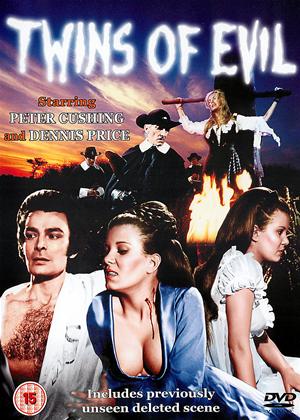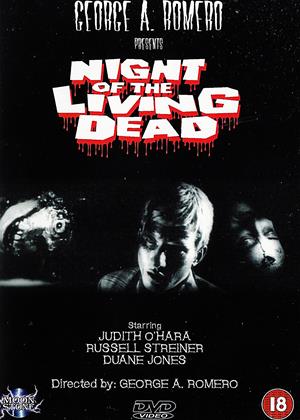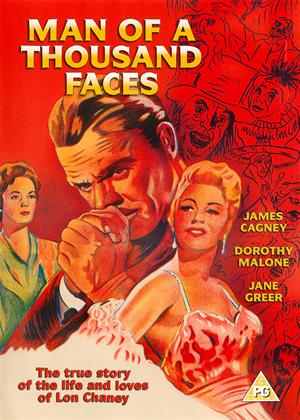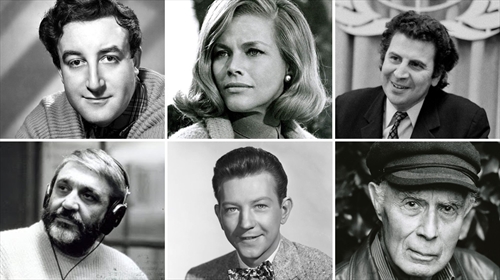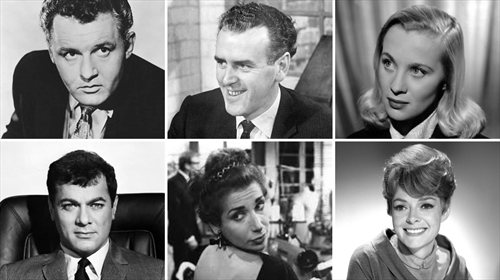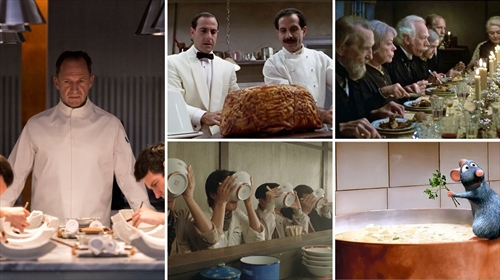Why on earth would Cinema Paradiso want to venture into a vault shrouded in darkness and covered with cobwebs? Perhaps because the pictures produced by Hammer in the two decades from 1957 remain among the best horrors ever made in Britain? And, maybe, just maybe, because it's Halloween...
Rooted in the rich Gothic literary tradition, the British horror film has gone through several phases since George A. Smith made Photographing a Ghost (1898). The earliest available film on disc, however, is Walter R. Booth's The Haunted Curiosity Shop (1901). Produced at the Animatograph Works studio in Muswell Hill, this can be rented from Cinema Paradiso via R.W. Paul: The Collected Films 1895-1908 (2008). Sadly, however, the chances of seeing titles like Frank Wilson's Dr Trimball's Verdict (1913) and Cecil Hepworth's The Basilisk (1914) seem remote. But these appear to have been isolated horrors rather than forming part of any burgeoning genre.
An Eerie Silence

As we saw in the Cinema Paradiso article, 100 Years of German Expressionism, defeat in the Great War prompted the production of horrors like Robert Wiene's The Cabinet of Dr Caligari (1920) and F.W. Murnau's Nosferatu (1922), which reflected Germany's scarred psyche. The chilling melodramas made in Hollywood by director Tod Browning and chameleonic actor Lon Chaney served a similar purpose, as is suggested in Joseph Pevney's biopic, Man of a Thousand Faces (1957), which stars James Cagney.
By contrast, despite American director George Loane Tucker making the Frankensteinian Man Without a Soul (1916) in Britain, no such postwar horror tradition emerged in this country, in spite of the fact that a handful of films reflected the rising interest in spiritualism, as the bereaved sought to contact those lost in the trenches of the Western Front. Among the rare examples of British chillers in the silent period are Will Barker's The Picture of Dorian Gray (1916), Alexander Butler's The Sorrows of Satan (1917) and The Beetle (1919), and Maurits Binger and B.E. Doxat-Pratt's Anglo-Dutch mystery, The Other Person (1921).
Slaughter By Name
The coming of sound did little to change the situation, despite the success of the Universal cycle in the early 1930s (see Cinema Paradiso's Halloween special, Top Horror Franchise Movies ). Boris Karloff returned from Hollywood at the invitation of Gaumont boss Michael Balcon to play an Egyptologist seeking the power of rejuvenation in T. Hayes Hunter's The Ghoul (1933), which became the first British film to receive the 'H' for Horror certificate from the Board of Censors. He returned when Balcon (who was now at Gainsborough) teamed him with Anna Lee in the sci-fi thriller, The Man Who Changed His Mind (1936).
Sadly, we can't bring you Bela Lugosi's Thameside sojourn in Walter Summers's The Dark Eyes of London, but we can offer the wonderful Tod Slaughter in George King's The Crimes of Stephen Hawke (1936). This forms part of a macabre triple bill with It's Never Too Late to Mend (1937) and The Face At the Window (1939). Also available from Cinema Paradiso are such Slaughter fests as Milton Rosmer's Maria Marten, or The Murder in the Red Barn (1935), King's Sweeney Todd: The Demon Barber of Fleet Street (1936) and Crimes At the Dark House (1940), Victor M. Gover's The Curse of the Wraydons (1946), and Oswald Mitchell's The Greed of William Hart (1948), a body-snatching saga based on the nefarious exploits of the Edinburgh grave robbers who also feature in Dennis Vance's The Anatomist (1956), John Gilling's The Flesh and the Fiends (1960), Vernon Sewell's Burke and Hare (1972), and John Landis's Burke and Hare (2010).

Despite sharing a name, Widgey R. Newman's Castle Sinister (1932) and Oscar Burn's Castle Sinister (1948) have little else in common, as the former sees a girl's brain transplanted into an ape, while the latter is an old dark house murder mystery. It's available from Cinema Paradiso in a double bill with Michael McCarthy's thriller, Crow Hollow (1952). Newman's film is considered lost, along with Maurice Elvey's Maria Marten, or The Murder in the Red Barn (1913), Marshall Neilan's Black Waters (1929), Harcourt Templeman and Oscar Weindorf's The Bells (1931), and Newman's own The Unholy Quest (1934). But we should never give up hope entirely, as five reels of Walter Forde's 1931 version of Arnold Ridley's stage success, The Ghost Train, were unexpectedly found after it was declared gone forever. And we can also hope that Forde's 1941 remake with Arthur Askey will show up on disc to join Marcel Varnel's Oh, Mr Porter! (1937), which shares its creepy sense of humour in creating the perfect vehicle for Will Hay, Moore Marriott and Graham Moffat (see Cinema Paradiso's article, Topping the Music Hall Bill ).
One of the last films to draw the 'H' certificate before it was withdrawn in 1951 was Ivan Barnett's The Fall of the House of Usher (1948), which is obtainable from Cinema Paradiso on a Renown triple bill that is completed by Frank R. Strayer's Who Killed Harvey Forbes? (aka Tangled Destinies, 1932) and Victor M. Gover's Murder At the Grange (1952). British horrors may still have been rare beasts. But that was about to change, thanks to a company that had previously specialised in light entertainments and quota quickie thrillers.
Hammering Home Its Advantage
Prior to Val Guest's The Quatermass Xperiment (1955), Hammer Productions had released 55 films. But, since launching with Bernard Mainwaring's 'lost' comedy, The Private Life of Henry the Ninth (1935), it hadn't had a horrific thought in its head. Indeed, bankruptcy meant it didn't produce a single film between The Bank Messenger Mystery (1936) and Death in High Heels (1947), which starred Don Stannard, who would go on to headline Alfred J. Goulding's Dick Barton, Special Agent (1948) and Godfrey Grayson's Dick Barton Strikes Back and Dick Barton At Bay (both 1949). Plans to make Dick Barton in Africa had to be shelved after Stannard was killed in a car crash after a studio wrap party.

All three cases can be found on The Dick Barton Trilogy. Like this, The Quatermass Xperiment was based on a BBC series. This 1953 classic scripted by Nigel Kneale can also rented from Cinema Paradiso, along with its sequels, Quatermass II (1955) and Quatermass and the Pit (1959), all three of which were directed by Rudolph Carter. Hammer's feature versions would come several years apart, but Val Guest's Quatermass II (1957) and Roy Ward Baker's Quatermass and the Pit (1967) are well worth watching (especially for Doctor Who fans).
Although he required a little uncredited help from Joseph Losey, Leslie Norman took the reins for X the Unknown (1956), another science fiction offering that traded on Cold War fears by centring around a radioactive Scottish chasm. However, censor Audrey Field suggested that the studio did more with the reactions of onlookers to generate terror than with hideous scars, sightless faces, and any form of 'pulsating obscenity'.
It was followed by Val Guest's The Abominable Snowman (1957), another adaptation of a Nigel Kneale teleplay that sent Peter Cushing and Forrest Tucker to the Himalayas. This confirmed that Hammer was no longer a B hive churning out quickie thrillers and it completed the transition to becoming a House of Horror with Terence Fisher's The Curse of Frankenstein (1957).
Frank'n'Vlad
Produced by Anthony Hinds and scripted by Jimmy Sangster, who would each play a key role in Hammer's success over the next decade, this is a loose reworking of the 1818 novel that Mary Shelley is seen composing in James Whale's Bride of Frankenstein (1935), Ken Russell's Gothic (1986), Gonzalo Suárez's Rowing With the Wind, Ivan Passer's Haunted Summer (both 1988), Haifaa Al-Mansour's Mary Shelley (2017), and Nora Unkel's A Nightmare Wakes (2020). Peter Cushing plays Baron Victor Frankenstein, whose obsession with creating life is matched by his passion for his wife, Elizabeth (Hazel Court). Well, almost and his scientific fixation leads to the unleashing of a brain-damaged Creature (Christopher Lee) that has no sense of right or wrong.
Cushing escaped execution to return in Fisher's The Revenge of Frankenstein (1958), which sees him transfer the brain of a hunchback (Oscar Quitak) into the body of a villager (Michael Gwynn). He would then reprise the role in Freddie Francis's The Evil of Frankenstein (1964), as Victor returns to Karlstaad and thaws the Creature (Kiwi Kingston) from a frozen cave. Hammer fans will always point out the disparities in this picture with its predecessors, as a deal with Universal meant that the scenario incorporated borrowings from Roy William Neill's Frankenstein Meets the Wolf Man (1943), while the make-up more closely resembled the look that Jack Pierce had devised for Boris Karloff's Creature in James Whale's Frankenstein (1931).
Foiled in his efforts, the Baron transplants the brain of the wrongfully guillotined Hans Werner (Robert Morris) into the body of his disfigured lover, Christina Kleve (Susan Denberg), in Fisher's Frankenstein Created Woman (1966), whose title mischievously plays on that of Roger Vadim's ...And God Created Woman (1958), which had introduced the world to Brigitte Bardot. The Baron conducts another operation in Fisher's Frankenstein Must Be Destroyed (1969), as he blackmails Dr Karl Holst (Simon Ward) into helping him place the brain of asylum inmate Dr Frederick Brandt (George Pravda) into the body of Professor Richter (Freddie Jones) in the hope of tapping into a breakthrough lost in the mists of madness.
Jimmy Sangster called the shots on The Horror of Frankenstein (1970), which he co-wrote with Jeremy Burnham to rework the original Shelley story as a darkly comic psycho saga, with Ralph Bates as the Baron and David Prowse as the Monster. But, while the latter returned to be the only Hammer actor to play the reanimated cadaver twice, Peter Cushing took over from Bates in Frankenstein and the Monster From Hell (1974), which remained on the shelf for two years and proved to be Terence Fisher's last feature. Set in an asylum, this ghoulish finale sees Frankenstein enlist the help of Dr Simon Helder (Shane Briant) and Sarah Krauss (Madeline Smith), the mute daughter of the institution's rapacious director, to rebuild a suicidal psychotic (Prowse).
Whereas Hammer's Frankenstein films contain contradictions that prevent them from having a narrative cohesion, the first five of the studio's features about Count Dracula have a linking logic. Adapted by Jimmy Sangster from Bram Stoker's 1897 epistolary novel, Terence Fisher's Dracula (1958) starred Christopher Lee as the Transylvanian vampire who is hunted down by Peter Cushing's Doctor Van Helsing after he targets sisters Lucy (Carol Marsh) and Mina Holmwood (Melissa Stribling).

Filmed in Eastmancolor, this knowing mix of dread and seduction brought gore to the Gothic. But Hammer couldn't persuade Lee to reprise his role and the Count is merely mentioned twice in passing in Fisher's The Brides of Dracula (1960), which sees Van Helsing (Cushing) striving to keep Marianne (Yvonne Monlaur) out of the clutches of the ravenous Baron Meinster (David Peel). Released in a double bill with Edward Dein's The Leech Woman, the picture did enough business to prompt the production of Don Sharp's The Kiss of the Vampire (1963), which is set in Bavaria in the 1910s and centres on the abduction of another Marianne (Jennifer Daniel) by the vampiric cult led by Dr Ravna (Noel Willman).
Despite claiming to have refused to deliver the substandard lines, a silently menacing Lee returned for Fisher's Dracula: Prince of Darkness (1965), which opens with the original film's climactic tussle before moving forward a decade to an English quartet accepting hospitality in a Karlsbad castle. Naturally, their stay proves eventful after a faithful minion mingles the blood of a snooping guest with the vampire's ashes. Barbara Shelley and Suzan Farmer play the sibling victims, while Francis Matthews joins forces with priest Andrew Keir to confound evil.
After Fisher broke a leg in a motoring accident, Freddie Francis assumed the director's chair for Dracula Has Risen From the Grave (1968), in which clergyman Rupert Davis accidentally revives Lee's count during an exorcism of his castle and he seeks revenge by making a play for his niece, Veronica Carlson. Breaking box-office records for a Hammer horror, this may not have been popular with the critics or purists who preferred the Bray Studios locations to the Pinewood settings used here. But it's well worth renting from Cinema Paradiso on either high-quality DVD or eye-popping Blu-ray.
Once again employing the pen name John Elder, producer Anthony Hinds scripted Peter Sasdy's Taste the Blood of Dracula (1969), which was released in a double bill with Alan Gibson's unjustly overlooked Crescendo (1970). Following on from its predecessor, this tale of bloody vengeance sees the Count (Lee) take over the corpse of disciple Lord Courtley (Ralph Bates) to punish the three philanthropists who had beaten him to death. The body-swapping had been a last-minute invention to get Lee into the action after Warner Bros had refused to distribute the film in the United States without him.
Even though Warners severed its ties with Hammer, Lee's return put paid to plans to allow Courtley to assume the neck-biting duties in order to give the studio more latitude in concocting storylines. So, Roy Ward Baker's Scars of Dracula (1970) drifted back in the direction of Stoker after having re-animated the Count (Lee) thanks to a blood infusion supplied by a vampire bat. Dennis Waterman and Jenny Hanley play the couple who travel to Kleinenberg in search of the former's missing brother and find an unexpected ally in Dracula's factotum (Patrick Troughton).

Needing more product for an insatiable market, Hammer sidelined the Count for Roy Ward Baker's The Vampire Lovers (1970), which was scripted by Tudor Gates from J. Sheridan Le Fanu's 1872 tome, Carmilla. Ingrid Pitt took the triple role of Marcilla, Carmilla and Mircalla, while Peter Cushing guests as her neighbour in 1790s Austria. Hammer would complete the 'Karnstein Trilogy' with Jimmy Sangster's Lust For a Vampire (1971) and John Hough's Twins of Evil (1972), which respectively saw Yutte Stensgard take on the Mircalla/Carmilla role and identical twins Mary and Madeline Collinson playing the nieces of Peter Cushing's witchfinding Puritan.
The latter was twinned in the United States with Peter Sasdy's Hands of the Ripper, an effective revisitation of a notorious murder case, in which Angharad Rees is traumatised by visions of her mother being murdered by her father, who happens to be Jack the Ripper. Dropped into the Karnstein mix was Robert Young's Vampire Circus (1972), which sees Anthony Higgins preying on the children of a mid-19th-century Serbian village. However, there was no keeping Christopher Lee down for long and he rose to torment Peter Cushing once more in Alan Gibson's Dracula A.D. 1972 (1972), as the unholy alliance between hippies Johnny Alucard (Christopher Neame) and Jessica Van Helsing (Stephanie Beacham) sets her grandfather, Lorrimer, on the trail of the vampire who had seemingly been offed on a train track by his ancestor, Lawrence (both Cushing).
Hammer stuck with a modern setting in Gibson's The Satanic Rites of Dracula (1973), which saw Lee don the cape and fangs for the seventh and final time for a last showdown with Cushing's professor. Joanna Lumley takes over the role of Jessica, as Van Helsing deduces that Dracula has finally tired of being undead, but wants to take the rest of civilisation with him when he dies. Lee and Cushing would never work together for Hammer again, although they would reunite in House of the Long Shadows (1983), which was directed by cult stalwart Pete Walker.
Searching for a new sub-franchise, Hammer recruited Horst Janson for Captain Kronos: Vampire Hunter (1974), which marked the directorial debut of Brian Clemens, who remains best known for his work on The Avengers (1961-91) and The Professionals (1977-80). However, the planned series was scrapped after an R rating in the US damaged its commercial prospects.
Seeking to cash in on the trend for martial arts pictures, the studio cast John Forbes-Robertson as Dracula in Roy Ward Baker's The Legend of the Seven Golden Vampires (1974), which was set in 1904, featured fight sequences choreographed by Chang Cheh, and teamed Peter Cushing and Robin Stewart as the pursuing Van Helsings. The latter will be best known to most as Sidney James and Diana Coupland's son in the ITV sitcom, Bless This House (1971-76). In 1972, this was spun-off to feature length by Carry On director, Gerald Thomas, by which time Hammer had started to realise that horror's moment was passing and it joined the sitcom boom with three more ITV spin-offs, Harry Booth's On the Buses (1971) and Mutiny on the Buses (1972), and Bryan Izzard's Holiday on the Buses (1973), which were followed by the John Robins quartet of That's Your Funeral, Nearest and Dearest (both 1972), Love Thy Neighbour (1973), and Man About the House (1974).
The Down Place Irregulars
In 1951, Hammer acquired a neglected 1750s mansion and, for 15 years, Down Place in Berkshire served as the its base and chief filming facility under the name Bray Studios. It was here that stalwarts like production designer Bernard Robinson, make-up creator Philip Leakey, composer James Barnard, and cinematographers Jack Asher, Arthur Grant and Freddie Francis contributed to the mournful menace that characterised Hammer's best pictures.

They didn't all feature Frankenstein and Dracula, however. Following the success of the first releases, a deal was struck with Universal for Hammer to rework some of its horror staples. A colour version of James Whale's The Invisible Man (1933) never materialised, but Herbert Lom swept Heather Sears into the London underworld in Terence Fisher's take on The Phantom of the Opera (1962), while Christy Cabanne's The Mummy's Hand (1940) became The Mummy (1959), which was produced by James Carreras, scripted by Jimmy Sangster, and directed by the prolific Fisher.
The Hollywood version is available from Cinema Paradiso in a double bill with Harold Young's The Mummy's Tomb (1942), as are Reginald Le Borg's The Mummy's Ghost and Leslie Goodwins's The Mummy's Curse (both 1944). The first of these provided Sangster with the ending for his scenario, in which Peter Cushing starred as archaeologist John Banning, whose search for the tomb of Princess Ananka (Yvonne Furneaux) accidentally resurrects mummified high priest, Kharis, who was played with bandaged malevolence by Christopher Lee. The film broke box-office records for a British horror and prompted Hammer to release Michael Carreras's The Curse of the Mummy's Tomb (1964), John Gilling's The Mummy's Shroud (1966), and Seth Holt's Blood From the Mummy's Tomb (1971). Based on Bram Stoker's The Jewel of the Seven Stars, the latter saw Peter Cushing quit after the first day's shooting in order to nurse his ailing wife and Michael Carreras complete the project after Holt died of a heart attack on set.
While Lee was often dismissive about his Hammer outings, Cushing was more enthusiastic, especially when it meant he landed plum roles like Sherlock Holmes, alongside André Morell's Doctor Watson, in Terence Fisher's The Hound of the Baskervilles (1959) and Professor Holly, opposite Ursula Andress as Ayesha, in Robert Day's adaptation of H. Rider Haggard's She (1965).
Neither star returned for Cliff Owen's The Vengeance of She (1968), by which time Hammer was subsisting on a roster of prehistoric romps, pirate adventures, and twisted thrillers. There were periodic returns to trusted topics in the likes of The Two Faces of Dr Jekyll (Terence Fisher, 1960), The Curse of the Werewolf (Fisher, 1961), and Dr Jekyll and Sister Hyde (Roy Ward Baker, 1971). They even teamed up with gimmick master William Castle for The Old Dark House (1963), which sought to put a comic spin on James Whale's 1932 classic of the same name, which had starred Boris Karloff and Charles Laughton.
Coming in the wake of Terence Fisher's underrated The Man Who Could Cheat Death (1959), in which Anton Diffring excels, some of the studio's 1960s offerings have become cult favourites, including John Gilling's The Shadow of the Cat (1961), Fisher's The Gorgon, Freddie Francis's Nightmare (both 1964), Cyril Frankel's The Witches, and Gilling's The Plague of the Zombies and The Reptile (all 1966). Christopher Lee also revelled in the title role of Don Sharp's Rasputin the Mad Monk (1966) and in playing Nicholas, Duc de Richelieu in Fisher's The Devil Rides Out (1968), which was scripted from a Dennis Wheatley novel by Richard Matheson, the esteemed sci-fi author who had earned his horror stripes writing four of the Edgar Allan Poe adaptations that Roger Corman had made for American International Pictures: The Fall of the House of Usher (1960); The Pit and the Pendulum (1961); Tales of Terror (1962); and The Raven (1963). These all starred Vincent Price, who had become the pin-up boy of Hollywood horror. But he never figured in a single Hammer feature.

By the end of the decade, game-changers like Roman Polanski's Rosemary's Baby and George A. Romero's Night of the Living Dead (both 1968) had transformed the genre by instituting the American Nightmare. As a consequence, Hammer horrors began to look quaint by comparison and the curtain came down on the golden era with Peter Sykes's To the Devil a Daughter (1976), another Wheatley adaptation that starred Richard Widmark and Nastassja Kinski. Fittingly, Christopher Lee took a supporting role, although he did return to the Hammer fold during its third incarnation, when he cameo'd as the antagonist's grandfather in Antti Jokinen's The Resident (2011).
Hammer's response to the new landscape was to pepper the schedule with psychological thrillers that were nicknamed 'mini-Hitchcocks' because of the influence of Psycho (1960). For the squeamish who like chills without the spills, let Cinema Paradiso recommend Seth Holt's Taste of Fear (1961), Michael Carreras's Maniac, Freddie Francis's Paranoiac! (both 1963), Silvio Narizzano's Fanatic (aka Die! Die! My Darling!), Holt's The Nanny (both 1965), Jimmy Sangster's Fear in the Night, Peter Sykes's Demons of the Mind, and Peter Collinson's Straight on Till Morning (all 1972).
While its feature days ended with Anthony Page's The Lady Vanishes (1978) - an ill-judged remake of Alfred Hitchcock's 1938 original - Hammer migrated to the small screen for the 13 chillers contained in Hammer House of Horror (1980). Note that Peter Cushing's Hammer farewell came as a pet shop owner in the seventh episode, 'The Secret Scream'.
Hammer's first excursion into living-rooms, Journey to the Unknown (1968-69), has never been released on disc. But Cinema Paradiso users can come up to date with the Hammer story, as it's possible to rent such revival items as Matthias Hoene's Beyond the Rave (2008), David Keating's Wake Wood (2009), Matt Reeves's Let Me In (2010), James Watkins's The Woman in Black (2012), John Pogue's The Quiet Ones, and Tom Harper's The Woman in Black: Angel of Death (both 2014). Missing, sadly, is Veronika Franz and Severin Fiala's The Lodge (2019), as this is the only feature in the whole history of Hammer not to have been directed by a man!

-
The Curse of Frankenstein (1957) aka: Frankenstein and the Monster
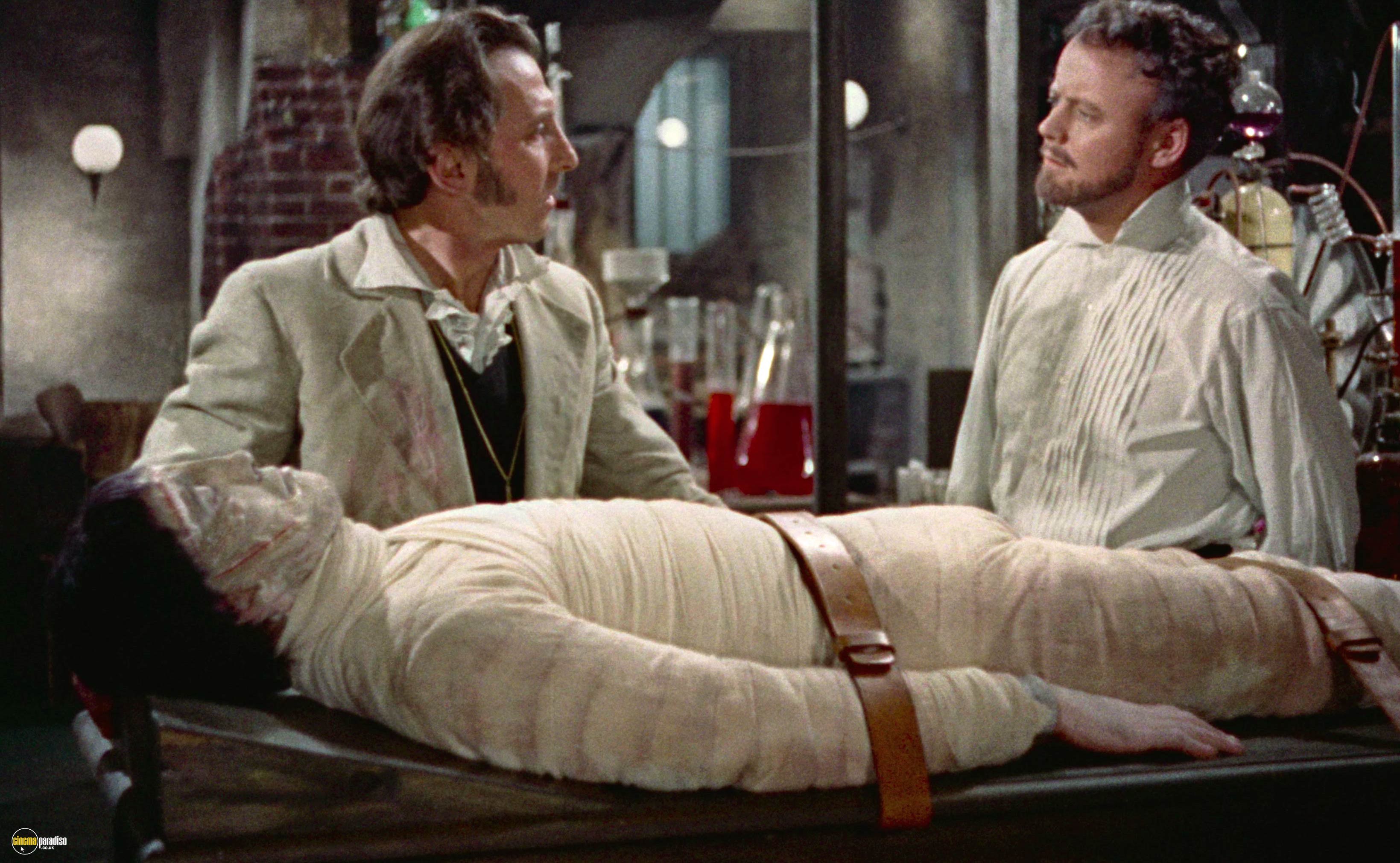 Play trailer1h 20minPlay trailer1h 20min
Play trailer1h 20minPlay trailer1h 20minDespite the British censor being appalled by the 'preoccupation with horror and gruesome detail', Terence Fisher's adaptation of Mary Shelley's Gothic masterpiece caught the imagination of the viewing public. It also proved a significant influence on the rise of lurid giallo thrillers in Italy and Roger Corman's Poe cycle in Hollywood. Peter Cushing and Christopher Lee are magnificent, but the star is Jack Archer for the reds he achieved with the Eastmancolor stock.
- Director:
- Terence Fisher
- Cast:
- Peter Cushing, Hazel Court, Robert Urquhart
- Genre:
- Horror, Sci-Fi & Fantasy, Thrillers, Classics
- Formats:
-
-
Dracula (1958)
 Play trailer1h 19minPlay trailer1h 19min
Play trailer1h 19minPlay trailer1h 19minAn increased budget of £81,412 allowed Hammer to splash out on Technicolor for their adaptation of Bram Stoker's haunting tome. Once again, censor Audrey Fields had misgivings, notably with screenwriter Jimmy Sangster's 'uncouth, uneducated, disgusting and vulgar style' and the fact that vampires were 'messier eaters than anyone else'. Christopher Lee brought seductive suavity to the title role, while Peter Cushing's Van Helsing had a moral authority that registered with British audiences reeling from the Suez Crisis.
- Director:
- Terence Fisher
- Cast:
- Peter Cushing, Christopher Lee, Michael Gough
- Genre:
- Classics, Horror
- Formats:
-
-
The Hound of the Baskervilles (1959) aka: Der Hund von Baskerville
 Play trailer1h 23minPlay trailer1h 23min
Play trailer1h 23minPlay trailer1h 23minBecoming the first Sherlock Holmes mystery to be filmed in colour, Hammer's take on Sir Arthur Conan Doyle's Devonian chiller benefitted greatly from Peter Cushing's reverence for the original stories. Such was his authenticity alongside André Morell's Doctor Watson that it didn't seem to matter that Christopher Lee looms a little too large to convince as the fearful Henry Baskerville or that Chobham Common and Frencham Ponds in Surrey had stood in for the wilds of Dartmoor.
- Director:
- Terence Fisher
- Cast:
- Peter Cushing, André Morell, Christopher Lee
- Genre:
- Thrillers, Classics
- Formats:
-
-
The Mummy (1959)
 Play trailer1h 25minPlay trailer1h 25min
Play trailer1h 25minPlay trailer1h 25minDespite sharing a title with Karl Freund's The Mummy (1932), Hammer Egyptian sojourn has more in common with the sequels that Universal churned out in the early 1940s. Felix Aylmer and Peter Cushing make a splendid father-and-son team, but they pay a severe price for desecrating the burial place guarded by Christopher Lee's vengeful high priest. For once, the BBFC got its way over cuts to the violence meted out to Kharis in times ancient and modern.
- Director:
- Terence Fisher
- Cast:
- Peter Cushing, Christopher Lee, Yvonne Furneaux
- Genre:
- Classics, Action & Adventure, Drama, Horror
- Formats:
-
-
The Curse of the Werewolf (1961)
 1h 27min1h 27min
1h 27min1h 27minGuy Endore's The Werewolf of Paris (1933) provided the inspiration for Terence Fisher's dalliance with lycanthropy. The action was relocated to 18th-century Madrid because the studio wanted to use the sets built for The Rape of Sabena, which had been abandoned after the BBFC objected to the script. Oliver Reed reveals a sensitive side in his first starring role, although the picture was muzzled by the censors and a restored version only emerged in 1993.
- Director:
- Terence Fisher
- Cast:
- Clifford Evans, Oliver Reed, Yvonne Romain
- Genre:
- Classics, Horror
- Formats:
-
-
The Reptile (1966)
 Play trailer1h 26minPlay trailer1h 26min
Play trailer1h 26minPlay trailer1h 26minIt's a toss up whether this or The Gorgon makes it into Cinema Paradiso's Hammer Top 10. But Jacqueline Pearce's performance tips the balance, as she suffers horrendously at the hands of a cruel father and the hideous curse foisted upon her by a Malayan snake cult. She had also impressed as an 1860s doctor's wife in The Plague of the Zombies, which John Gilling had filmed on the same Cornish sets.
- Director:
- John Gilling
- Cast:
- Noel Willman, Jennifer Daniel, Ray Barrett
- Genre:
- Classics, Horror
- Formats:
-
-
The Witches (1966)
 1h 28min1h 28min
1h 28min1h 28minHammer had long imported Hollywood stars to give its pictures some clout at the US box office. Bette Davis headlined The Nanny (1965) and The Anniversary (1968), but Joan Fontaine's performance as an accidental witch-hunter in Nigel Kneale adaptation of Norah Lofts's novel, The Devil's Own, is perhaps more memorable, if only because she had made a career of playing shrinking ingenues. Kay Walsh is equally striking in leading a fine ensemble.
- Director:
- Cyril Frankel
- Cast:
- Joan Fontaine, Kay Walsh, Alec McCowen
- Genre:
- Horror
- Formats:
-
-
The Devil Rides Out (1968) aka: The Devil's Bride
 Play trailer1h 31minPlay trailer1h 31min
Play trailer1h 31minPlay trailer1h 31minCinema's struggle to make the most of Dennis Wheatley's page-turners is one of screen history's more baffling mysteries. Terence Fisher's take on a 1934 bestseller somehow failed at the box office. But the battle of wills between Christopher Lee's heroic occultist and Charles Gray's sinister Satanist is waged with a gravitas that went against Hammer's late-60s tendency to camp things up. Bristling with cunning twists and canny effects, the climactic black magic showdown remains truly terrifying.
- Director:
- Terence Fisher
- Cast:
- Christopher Lee, Charles Gray, Nike Arrighi
- Genre:
- Classics, Horror
- Formats:
-
-
The Vampire Lovers (1970) aka: Amores de vampiros
 Play trailer1h 27minPlay trailer1h 27min
Play trailer1h 27minPlay trailer1h 27minA Holocaust survivor who shortened her Polish first name and retained the surname of her American soldier ex-husband, Ingrid Pitt became a horror icon in the 1970s. She exudes sensual menace in Hammer's reworking of J. Sheridan Le Fanu's Carmilla, which was co-produced with AIP in order to exploit Hollywood's relaxed censorship code. It's undoubtedly guilty of male gaze accusations, but few films of its time bothered to explore female power and desire.
- Director:
- Roy Ward Baker
- Cast:
- Ingrid Pitt, Pippa Steel, Madeline Smith
- Genre:
- Classics, Horror
- Formats:
-
-
Dr. Jekyll and Sister Hyde (1971) aka: Dr Jekyll & Sister Hyde
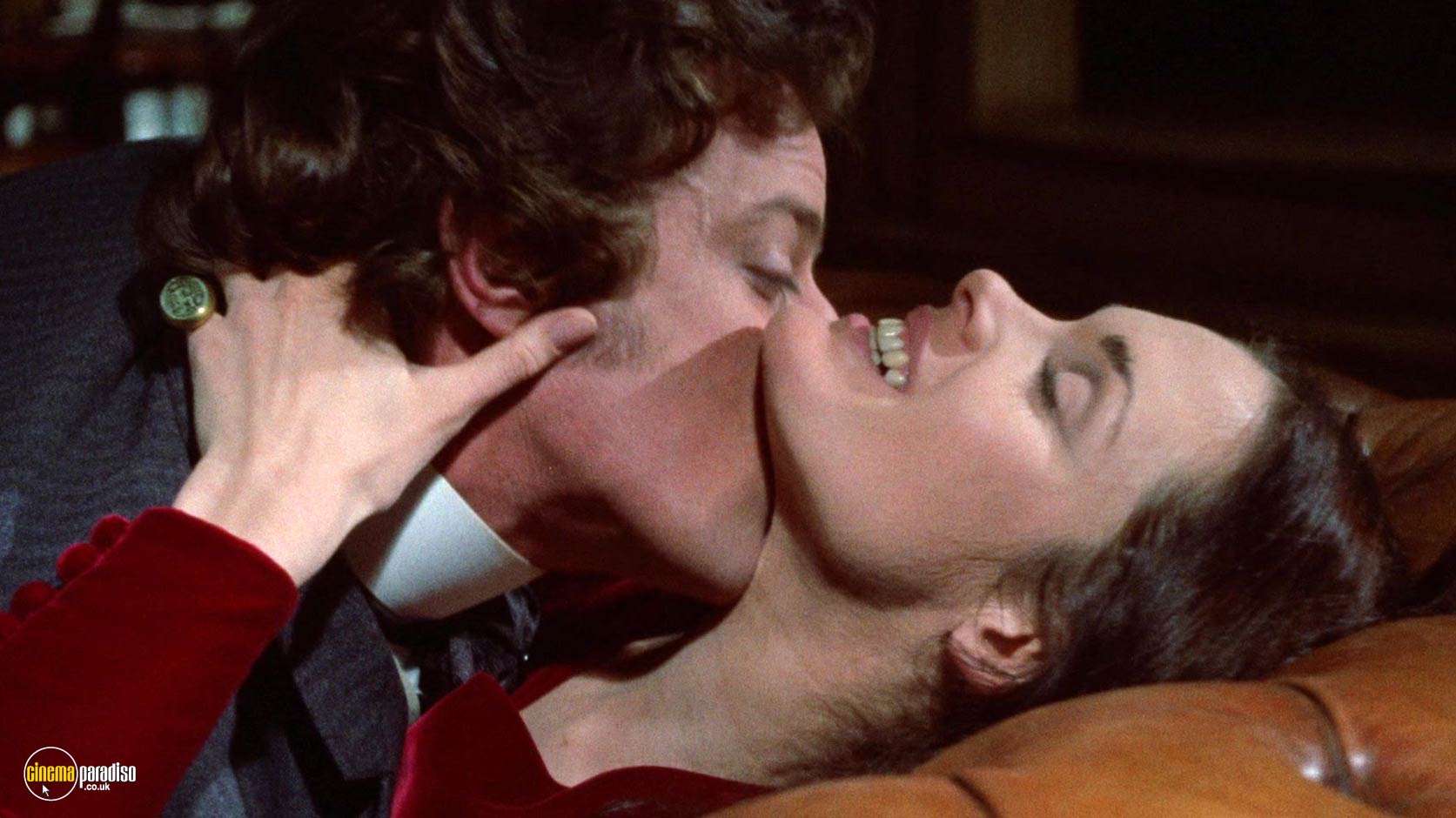 Play trailer1h 33minPlay trailer1h 33min
Play trailer1h 33minPlay trailer1h 33minBrian Clemens devised this delicious twist on Robert Louis Stevenson's 1886 novella. Ralph Bates is typically intense as the medic who is distracted from his work by upstairs neighbour Susan Brodrick. However, her brother, Lewis Fiander, becomes equally enamoured when Bates's experiments with female hormones result in an elixir that turns him into Martine Beswick (whom he passes off as his own disreputable sibling). Taking itself just seriously enough, this is another Hammer horror featuring those handy bodysnatchers Burke and Hare.
- Director:
- Roy Ward Baker
- Cast:
- Ralph Bates, Martine Beswick, Gerald Sim
- Genre:
- Classics, Horror, Sci-Fi & Fantasy
- Formats:
-


































